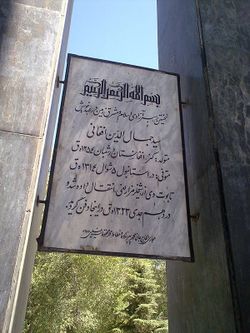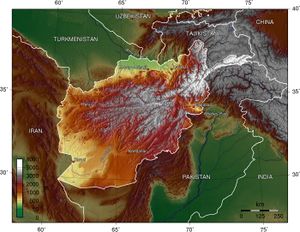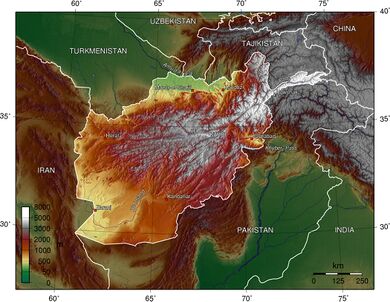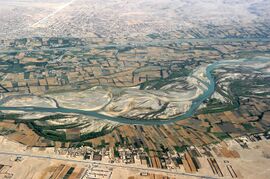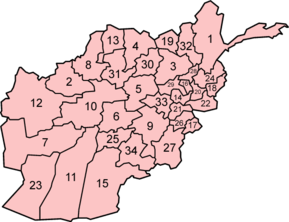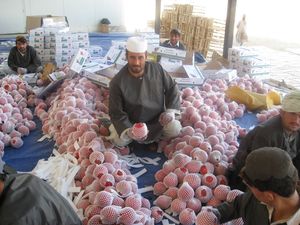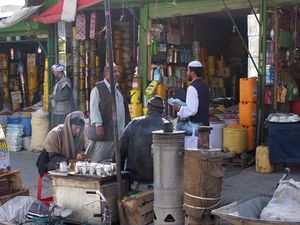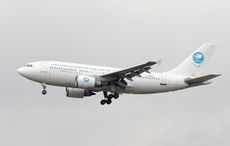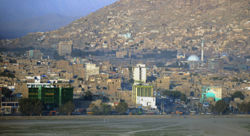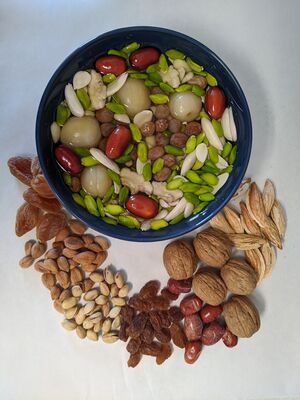أفغانستان
أفغانستان | |
|---|---|
الشعار الحادي: لا إله إلا الله محمد رسول الله | |
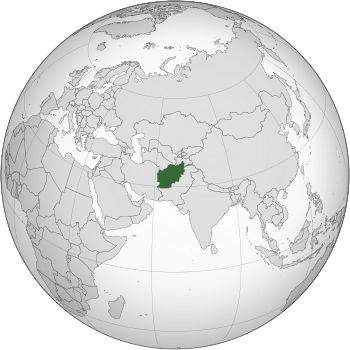 | |
| العاصمة و أكبر مدينة | كابول 33°N 66°E / 33°N 66°E[1] |
| اللغة الرسمية | |
| الجماعات العرقية | |
| الدين | |
| صفة المواطن | أفغاني[أ][5][6] |
| الحكومة |
|
| التشكل | |
| 1709–1738 | |
| 1747–1842 | |
• إمارة | 1823–1926 |
• الاعتراف | 19 أغسطس 1919 |
• مملكة | 9 يونيو 1926 |
| 17 يوليو 1973 | |
| 7 سبتمبر 1996 | |
| 26 يناير 2004 | |
| 15 أغسطس 2021 | |
| المساحة | |
• الإجمالية | 652،864[7] km2 (252،072 sq mi) (40th) |
• الماء (%) | لا يُذكر |
| التعداد | |
• تقدير 2020 | 31,390,200[8] (44th) |
• الكثافة | 48.08/km2 (124.5/sq mi) (174th) |
| ن.م.إ. (ق.ش.م.) | تقدير 2018 |
• الإجمالي | $72.911 billion[9] (96th) |
• للفرد | $2,024[9] (169th) |
| ن.م.إ. (الإسمي) | تقدير 2018 |
• الإجمالي | $21.657 billion[9] (111st) |
• للفرد | $493[9] (177th) |
| جيني (2008) | ▼ 27.8[10] low · 1st |
| م.ت.ب. (2019) | ▲ 0.511[11] low · 169th |
| العملة | أفغاني (افغانی) (AFN) |
| التوقيت | UTC+4:30 Solar Calendar (D†) |
| جانب السواقة | right |
| مفتاح الهاتف | +93 |
| النطاق العلوي للإنترنت | .af افغانستان. |
أفغانستان، رسمياً جمهورية أفغانستان الإسلامية هي دولة تقع في آسيا الوسطى تحدها من كل من طاجكستان وأوزبكستان وتركمانستان من الشمال وإيران من الغرب والصين من الشرق فيما تحدها باكستان من الجنوب. ومعنى كلمة "أفغانستان" هو أرض الأفغان[12]، وتعتبر إحدى نقاط الاتصال القديمة لطريق الحرير والهجرات البشرية السابقة. وتلك الدولة ذات موقع جيوسترتيجي تربط شرق وغرب وجنوب ووسط آسيا[13]، وهي موطن لكثير من الأمم القديمة والحديثة خلال العصور المتتالية. وكانت المنطقة هدفا لكثير من الشعوب الغازية والفاتحين منذ القدم، منذ عهد المقدونيون القدماء تحت حكم إسكندر الأكبر، ومرورا بالفتوحات الإسلامية وحكم المغول وغيرهم. وقد عملت أفغانستان كمنبع للعديد من الممالك، مثل مملكة باكتريا الإغريقية والكوشانيون والهياطلة السامانيون والغزنويون التيموريون، وممالك أخرى ظهرت في أفغانستان فشكلت دول عظمى هيمنت على جيرانها من الممالك الأخرى.[14].
الأفغان بهذا المصطلح شعب معروف في التاريخ الاسلامي من الشعوب الآرية[15] "أخوة الفرس والاكراد والطاجيك [16]" يسكن هذه البقاع نفسها ولقد ذكرهم عدد كبير من المؤرخين[17][18]، ووصفهم بالقوة والبأس الشديد،الرحالة ابن بطوطة عند زيارته لمدينة كابل وما جاورها [19].
منذ القرن ال18 مع ظهور قبائل البشتون بدأ التاريخ السياسي الحديث لأفغانستان عندما أسس أحمد شاه الدراني سلالة الهوتاكي سنة 1709 حكمها في قندهار، مكونا مملكة دراني سنة 1747- آخر الممالك الأفغانية[20]، والأم الشرعية لأفغانستان الحديثة[21][22][23]. فانتقلت العاصمة سنة 1776 من قندهار إلى كابول، وقد تنازلت عن معظم أراضيها للممالك المجاورة. وفي أواخر القرن ال19 أضحت أفغانستان دولة حاجزة في لعبة الأمم ما بين إمبراطوريتي الروسية والبريطانية[24]. ففي تاريخ 19 أغسطس 1919 بعيد الحرب الإنجليزية الأفغانية الثالثة استعاد البلد الاستقلالية في سياسته الخارجية من المملكة المتحدة.
مع أواخر سبعينات القرن الماضي عاشت أفغانستان تجربة مريرة من الحرب الأهلية الأفغانية تخللها احتلال أجنبي عام 1979 تمثل في الغزو السوفيتي تلاه الغزو الأمريكي لأفغانستان عام 2001.
بدأت دولة أفغانستان الحديثة مع أسرتي هوتاك ودوراني في القرن الثامن عشر. في أواخر القرن التاسع عشر، أصبحت أفغانستان دويلة حاجزة في اللعبة الكبرى بين الهند البريطانية و الإمبراطورية الروسية. بعد الحرب الأنگلو-أفغانية الثالثة في عام 1919، كانت البلاد خالية من النفوذ الأجنبي، وأصبحت في النهاية حكومة ملكية تحت الملك أمان الله، حتى ما يقرب من 50 عاماً بعد ذلك عندما أطاح به ظاهر شاه وأنشئت جمهورية. في عام 1978، بعد الانقلاب الثاني أصبحت أفغانستان دولة اشتراكية، مما أثار الحرب الأفغانية-السوڤيتية في الثمانينيات ضد مجاهدين المتمردين. بحلول عام 1996، استولت جماعة الأصولية الإسلامية على معظم أفغانستان، التي حكمت معظم البلاد كنظام استبدادي لأكثر من خمس سنوات. تمت الإطاحة بحركة طالبان من السلطة بعد الغزو الأمريكي في عام 2001 لكنها لا تزال تسيطر على جزء كبير من البلاد. وصلت الحرب التي استمرت عشرين عاماً بين الحكومة وطالبان ذروتها مع هجوم طالبان 2021 و مما أدى إلى سقوط كابول التي أعادت طالبان إلى السلطة.
لدى البلاد مستويات عالية من الإرهاب، الفقر، سوء تغذية الأطفال، الفساد. وهي عضو في الأمم المتحدة، و منظمة التعاون الإسلامي، و اتحاد جنوب آسيا للتعاون الإقليمي، و مجموعة الـ77، و منظمة التعاون الاقتصادي، و حركة عدم الانحياز. يحتل الاقتصاد الأفغاني المرتبة 96 في العالم، حيث يبلغ الناتج المحلي الإجمالي 72.9 مليار دولار من خلال القدرة الشرائية المعادلة؛ البلد أسوأ بكثير من حيث نصيب الفرد من الناتج المحلي الإجمالي (PPP)، حيث احتلت المرتبة 169 من بين 186 دولة اعتباراً من 2018.
التاريخ
 مقالة مفصلة: تاريخ أفغانستان
مقالة مفصلة: تاريخ أفغانستان
لأفغانستان تاريخ طويل من الحروب الأهلية والخارجية، ومنذ رحيل السوفييت عام 1989، دارت رحى العديد من الحروب الداخلية في البلاد.
في 24 أبريل 1992، تم توقيع اتفاق عرف باسم اتفاق بيشاور من قبل أحزاب الإتحاد الإسلامي لمجاهدي أفغانستان السبعة وحزب الوحدة الشيعي والحركة الإسلامية محسني، فتم الاتفاق على تشكيل حكومة مؤقتة لمدة شهرين وعلى رأسها صبغة الله مجددي، ثم يتبعه ولمدة أربعة أشهر برهان الدين رباني. ولكن الحزب الإسلامي بقيادة حكمتيار والذی کان موالیاً ل باکستان رفض الاتفاقية بالرغم من أنه من الموقعين عليها. فهاجم كابل وانهارت الاتفاقية، وبقي رباني في رئاسة الدولة.
عادت الأحزاب المتناحرة لتجتمع في 7 مارس 1993 في إسلام أباد في باكستان بعد حرب ضروس ومعارك طاحنة في كابل، وتم توقيع اتفاقية عرفت باتفاقية إسلام أباد، وشاركت فيها السعودية وباكستان، ونصت الاتفاقية على أن لرباني رئاسة الدولة لمدة 18 شهرا، وقلب الدين حكمت يار يتولى رئاسة الوزراء، وأن يتم إيقاف إطلاق النار. ولكن الاتفاقية لم تنفذ بسبب اندلاع القتال من جديد بين رباني وحكمتيار بسبب الاتهامات المتبادلة بين الحزب الإسلامي والجمعية.
في الأول من يناير عام 1994 تعرض برهان الدين رباني لمحاولة انقلاب بيد تحالف بين حكمتيار وعبد الرشيد دوستم وصبغة الله مجددي وحزب الوحدة الشيعي، ولكن الانقلاب فشل، من قبل أحمد شاه مسعود وتم تجديد فترة حكم رباني لعام آخر في يوليو 1994. وفي نوفمبر 1994 بدأت طالبان بالظهور، وخلال عامين سيطرت على معظم مناطق أفغانستان ودخلت كابول عام 1996 وأعلنت نفسها الحاكمة للبلاد بإزاحة رباني وحكمتيار الذي وقع مع رباني اتفاقية عام 1996 أيضا تقضي بالعمل المشترك واقتسام السلطة.واستمرت سيطرة طالبان حتى بدأت القوات الأمريكية بضرب قوات طالبان في 7 أكتوبر 2001 وذلك بسبب هجمات 11 سبتمبر 2001 التي استهدفت برجي التجارة العالميين.
ظهور طالبان مجدداً
في 14 أبريل 2021، قال الأمين العام لحلف الناتو ينز ستولتنبرگ إن الحلف وافق على بدء سحب قواتها من أفغانستان بحلول 1 مايو.[26] بعد وقت قصير من بدء انسحاب قوات الناتو، شنت طالبان هجوماً ضد الحكومة الأفغانية، وتقدمت بسرعة أمام القوات الحكومية الأفغانية المنهارة.[27][28] وفقاً لـ لتقرير استخباراتي أمريكي، من المرجح أن تنهار الحكومة الأفغانية في غضون ستة أشهر بعد أن يكمل الناتو انسحابه من البلاد.[29]في 15 أغسطس 2021، عندما سيطرت طالبان مرة أخرى على الغالبية العظمى من الأراضي الأفغانية، بدأت طالبان في الاستيلاء على العاصمة كابول، وتم إجلاء العديد من المدنيين والمسؤولين الحكوميين والدبلوماسيين الأجانب.[30]وقد فر الرئيس غني من أفغانستان في ذلك اليوم.[31] اعتباراً من 16 أغسطس 2021، انعقد مجلس التنسيق غير الرسمي بقيادة كبار رجال الدولة بصدد تنسيق نقل مؤسسات الدولة في جمهورية أفغانستان الإسلامية إلى طالبان.[32]في 17 أغسطس، أعلن النائب الأول لرئيس جمهورية أفغانستان الإسلامية، أمر الله صالح، نفسه القائم بأعمال رئيس أفغانستان وأعلن تشكيل الجبهة المناهضة لطالبان في وادي پنجشیر، مع أحمد مسعود ووزير الدفاع بسم الله خان محمدي.[33][34]
الجغرافيا
Afghanistan is located in Southern-Central Asia.[35][36][37][38][39] The region centered at Afghanistan is considered the "crossroads of Asia",[40] and the country has had the nickname Heart of Asia.[41] The renowned Urdu poet Allama Iqbal once wrote about the country:
Asia is a body of water and earth, of which the Afghan nation is the heart. From its discord, the discord of Asia; and from its accord, the accord of Asia.
At over 652،864 km2 (252،072 sq mi),[42] Afghanistan is the world's 41st largest country,[43] slightly bigger than France and smaller than Myanmar, and about the size of Texas in the United States. There is no coastline, as Afghanistan is landlocked. Afghanistan shares its longest land border (the Durand Line) with Pakistan to the east and south, followed by borders with Tajikistan to the north-east, Iran to the west, Turkmenistan to the north-west, Uzbekistan to the north and China to the north-east; India recognizes a border with Afghanistan through Pakistani-administered Kashmir.[44] Clockwise from south-west, Afghanistan shares borders with the Sistan and Baluchestan Province, South Khorasan Province and Razavi Khorasan Province of Iran; Ahal Region, Mary Region and Lebap Region of Turkmenistan; Surxondaryo Region of Uzbekistan; Khatlon Region and Gorno-Badakhshan Autonomous Region of Tajikistan; Xinjiang Uyghur Autonomous Region of China; and the Gilgit-Baltistan territory, Khyber Pakhtunkhwa province and Balochistan province of Pakistan.[45]
The geography in Afghanistan is varied, but is mostly mountainous and rugged, with some unusual mountain ridges accompanied by plateaus and river basins.[46] It is dominated by the Hindu Kush range, the western extension of the Himalayas that stretches to eastern Tibet via the Pamir Mountains and Karakoram Mountains in Afghanistan's far north-east. Most of the highest points are in the east consisting of fertile mountain valleys. The Hindu Kush ends at the west-central highlands, creating plains in the north and southwest, namely the Turkestan Plains and the Sistan Basin; these two regions consist of rolling grasslands and semi-deserts, and hot windy deserts, respectively.[47] Forests exist in the corridor between Nuristan and Paktika provinces (see East Afghan montane conifer forests),[48] and tundra in the north-east. The country's highest point is Noshaq, at 7،492 m (24،580 ft) above sea level.[49] The lowest point lies in Jowzjan Province along the Amu River bank, at 258 m (846 ft) above sea level.
Despite having numerous rivers and reservoirs, large parts of the country are dry. The endorheic Sistan Basin is one of the driest regions in the world.[50] The Amu Darya rises at the north of the Hindu Kush, while the nearby Hari Rud flows west towards Herat, and the Arghandab River from the central region southwards. To the south and west of the Hindu Kush flow a number of streams that are tributaries of the Indus River,[46] such as the Helmand River. One exception is the Kabul River which flows in an easternly direction to the Indus ending at the Indian Ocean.[51] Afghanistan receives heavy snow during the winter in the Hindu Kush and Pamir Mountains, and the melting snow in the spring season enters the rivers, lakes, and streams.[52][53] However, two-thirds of the country's water flows into the neighboring countries of Iran, Pakistan, and Turkmenistan. As reported in 2010, the state needs more than US$2 billion to rehabilitate its irrigation systems so that the water is properly managed.[54]
The northeastern Hindu Kush mountain range, in and around the Badakhshan Province of Afghanistan, is in a geologically active area where earthquakes may occur almost every year.[55] They can be deadly and destructive, causing landslides in some parts or avalanches during the winter.[56] The last strong earthquakes were in 1998, which killed about 6,000 people in Badakhshan near Tajikistan.[57] This was followed by the 2002 Hindu Kush earthquakes in which over 150 people were killed and over 1,000 injured. A 2010 earthquake left 11 Afghans dead, over 70 injured, and more than 2,000 houses destroyed.
المناخ
لأفغانستان مناخ قاري قاسي شتاء، يميز البرد يميز المرتفعات، الصيف دافيء باستثناء المرتفعات الأكثر علوا، معظم البلاد جافّة أو شبه جافّة، والأمطار خفيفة تسقط عادة في الشتاء والربيع، ولا تسقط أي أمطار بين شهري يونيو وأكتوبر.
التقسيمات الإدارية
وتنقسم إداريا إلى 34 ولاية في أفغانستان (ولايات)، مع وجود كل محافظة عاصمتها الخاصة وإدارة المحافظات. تنقسم المحافظات إلى مناطق حول المقاطعة 398 أصغر، كل منها يغطي عادة المدينة أو عدد من القرى. ويمثل كل دائرة من قبل حاكم المقاطعة.
ويعين حكام المقاطعات من قبل رئيس أفغانستان، ويتم اختيار حكام المقاطعات من قبل حكام المقاطعات. حكام المقاطعات وممثلين عن الحكومة المركزية في كابول، وهي المسؤولة عن جميع المسائل الإدارية والرسمية داخل محافظاتهم. وهناك أيضا مجالس المحافظات التي انتخبت من خلال انتخابات مباشرة وعامة لمدة أربع سنوات.[58] وظائف مجالس المحافظات ومن المقرر ان يشارك في التخطيط للتنمية المحلية، والمشاركة في رصد وتقييم مؤسسات الحكم الأخرى المحافظات.
وفقا للمادة 140 من الدستور والمرسوم الرئاسي على قانون الانتخابات، ينبغي انتخاب رؤساء بلديات المدن من خلال انتخابات حرة ومباشرة لمدة أربع سنوات. ومع ذلك، نظرا لتكاليف الانتخابات ضخمة، لم تكن الانتخابات البلدية والبلدية التي جرت. بدلا من ذلك، فقد تم تعيين رؤساء البلديات من قبل الحكومة. أما بالنسبة للعاصمة كابول، ويتم تعيين رئيس البلدية من قبل رئيس أفغانستان.
وفيما يلي قائمة بأسماء جميع المقاطعات ال 34 في أفغانستان وفقا للترتيب الأبجدي على اليمين هو عبارة عن خريطة تظهر حيث يقع كل محافظة :-
السكان
- يتكون سكان أفغانستان من عدّة مجموعات عرقية هي:[59][60][61]
- البشتون،وهم "الأفغان" [62]، حوالي 62%[63][64].
- الطاجيك، حوالي 25% .
- الهزارة، حوالي 10-15%
- البلوش، حوالي 2% .
- التركمان ،حوالي2%.
- الأوزبك ،حوالي7,5% .
- * مجموعات أخرى، 2,5% .
اللغة
يتحدث الأفغان عدّة لغات بالتوزيع الآتي :
- اللغة الدارية ،"لغة رسمية" يتحدث بها نحو 40 في المائة ومفهومة من قبل أغلب السكان.[65].
- بشتو 60% وتعتبر اللغةالرسمية للنشيد الوطني ومفهومة من قبل أغلب السكان.[66][67]، والبشتو هي "اللغة الأفغانية"[68]
- اللغة الأوزبكية ويعيشوف في بعض مدن الشمال [68].
- اللغة العربية وهم قلة يعيشون في مدينة مزار شريف.
- اللغة البلوشية وتستخدمها الأقلية البلوشية في نيمروز وهلمند[69].
الدين
من الناحية الدينية، يعتبر أكثر من 99 ٪ من الأفغان من المسلمين ، الأغلبية من السنة مع أقلية من الشيعة تتمركز على الحدود مع إيران.[70][71][72][73] ، وحتى منتصف الثمانينيات من القرن الماضي، كان هناك نحو 30،000 إلى 150،000 من الهندوس والسيخ وهم يعيشون في مدن مختلفة، غالبًا في جلال آباد، وكابول، وقندهار.[74][75]
وكان تعيش في أفغانستان أقلية يهودية (انظر: يهود بخران)، والذين فروا من البلاد إبان الغزو السوفيتي، ولم يبق منهم إلا فرد واحد وهو، زبلون سيمينتوف[76]
الاقتصاد
 مقالة مفصلة: اقتصاد أفغانستان
مقالة مفصلة: اقتصاد أفغانستان
جمهورية أفغانستان هي عضوًا في رابطة دول جنوب آسيا للتعاون الاقليمى (سارك)، ومنظمة التعاون الاقتصادي (إكو) ومنظمة المؤتمر الإسلامي (أويك). تعد أفغانستان من الدول المعدمة، حتى أنها واحدة من أفقر دول العالم وأقلها نموا. حيث يعيش ثلثي السكان على أقل من 2 دولار أمريكي يوميًا. عانت أفغانستان أقتصاديا بشكل كبير من الغزو السوفيتي عام 1979 وما تلاه من صراعات، بينما زاد الجفاف الشديد في الفترة 1998-2001 من الصعوبات التي تواجهها الأمة.[77][78]
بلغ حجم النشاط الاقتصادي في عام 2002 نحو 11 مليون (من أصل إجمالي مقدر بـ 29 مليون)وفي عام 2005، بلغ المعدل الرسمي للبطالة 40%.[79] ويقدر عدد الشباب غير المؤهل بـ 3 مليون، وهذا العدد قابل للزيادة بمقدر 300,000 سنويا.[80]
بدأ الاقتصاد الوطني في التحسن منذ عام 2002 بسبب جلب مساعدات دولية واستثمارات تقدر بعدة مليارات دولار أمريكي، بالإضافة إلى تحويلات المغتربين.[81] ويرجع ذلك أيضًا إلى التحسينات الكبيرة في في مجال الإنتاج الزراعي ووضع حد لأربع سنوات من الجفاف الذي عمّ معظم أنحاء البلاد.

وتقدر القيمة الحقيقية لإجمالي الناتج المحلي من المنتجات باستثناء المواد المخدرة بنسبة 29٪ في عام 2002، و16٪ في عام 2003، و8٪ في عام 2004 و14 ٪ في عام 2005.[83] بينما يأتي ثلث إجمالي الناتج المحلي لأفغانستان من زراعة الخشخاش والاتجار غير المشروع بالمخدرات بمافي ذلك الأفيون، واثنين من مشتقاته وهما المورفين والهيرويين، فضلا عن إنتاج الحشيش.[71] وقد ارتفع انتاج الأفيون في أفغانستان إلى مستوى قياسي جديد في عام 2007 عن العام الذي سبقه حتى أنه قد تعدى الثلث، وذلك وفقا لما ذكرته الأمم المتحدة.[84] نحو 3,3 مليون أفغاني يشاركون في عملية إنتاج الأفيون حاليًا.[85] وفي مقال نشر مؤخرا في واشنطن كوارترلي، ناقش كل من بيتر فان وجوريت كمينجا ان المجتمع الدولي ينبغي أن يضع مشروع رائد، ويستثمر خطة منح التراخيص للبدء في إنتاج أدوية مثل المورفين والكودايين من محاصيل الخشخاش لمساعدة أفغانستان على الهرب من الاعتماد الاقتصادي على الأفيون.[86]
وفقا لتقرير صادر عن بنك التنمية الآسيوي عام 2004، أن جهود إعادة الإعمار تنقسم إلى شقين: الأول يركز على أهمية إعامدة بناء بنية أساسية حيوية وحاسمة، والثاني يركز على بناء مؤسسات حديثة للقطاع العام على طراز مخلفات الغزو السوفيتي، والتخطيط لتلك المؤسسات التي تروج لتنمية تقود السوق.[80]
وفي عام 2006، فازت الشركتان الأمريكيتان بلاك أند فينيش ولويز برجر جروب بعقد قيمته 1.4 مليار دولار لإعادة بناء الطرق وخطوط الكهرباء وشبكات إمدادات المياه في أفغانستان.[87]
إن إعادة أكثر من 4 ملايين لاجئ من البلدان المجاورة ومن الغرب، قد جلب وهؤلاء معهم طاقة جديدة وروح المبادرة ومهارات تكوين الثروة فضلا عن الكثير من الأموال اللازمة لبدء الأعمال التجارية، يعد واحدًا من الدعائم الرئيسية للإنعاش الاقتصادي الحالي. ومن العوامل المساعدة أيضا، المساعدت الدولية التي تقدر بـ 2-3 مليار دولار أمريكي في كل عام وهي مخصصة لعمليات الإنعاش الجزئي في قطاع الزراعة وإعادة تأسيس المؤسسات التجارية. كما أن أعمال التطوير الخاصة في طريقها للحاق بالركب.وفي عام 2006، افتتحت عائلة من أصل أفغاني تعيش في دبي مصنعًا لتعبئة الكوكا كولا في أفغانستان.[88]
في حين يتم تغطية العجز في الرصيد الحالي للبلاد بصورة كبيرة من خلال الأموال الممنوحة، إلا أن جزء صغير جدًا - حوالي 15% - يتم تحويله مباشرة إلى ميزانية الدولة.أما بقية الأموال فيتم صرفها في نفقات غير متعلقة بالميزانية، ومشروعات تحددها الجهات المانحة من خلال نظام تابع للأمم المتحدة و[[:: ar : المنظمات غير الحكومية|المؤسسات غير الحكومية]].وقد بلغت الميزانية المركزية لدى الحكومة فقط 350 مليون دولار أمريكي في 2003، في حين تم تقديرها في عام 2004 بـ 550 مليون دولار أمريكي.ويقدر إجمالي التبادل للعملات الأجنبي في البلاد حوالي 500 مليون دولار أمريكي.وتأتي معظم الإيرادات من خلال الجمارك، بالإضافة إلى ضريبة الدخل وضريبة الشركات.
وكان التضخم مشكلة كبيرة حتى عام 2002. ومع ذلك، فإن انخفاض قيمة العملة الأفغانية في عام 2002 بعد تقديم الملاحظات الجديدة (التي استبدلت 1,000 أفغاني قديم بأفغاني واحد جديد) بالاقتران مع استقرار نسبي بالمقارنة مع الفترات السابقة وساعد على استقرار الأسعار وانخفاض بين ديسمبر 2002 وفبراير 2003، مما يعكس تحولًا في تقدير العملة الأفغانية الجديدة. ومنذ ذلك الحين، وقد أشار مؤشر الاستقرار، مع زيادة معتدلة تجاه أواخر عام 2003.[80]
ويبدو أن الحكومة الأفغانية والجهات الدولية المانحة ما زالوا ملتزمين تحسين فرص الحصول على الضروريات الأساسية، وتطوير البنية التحتية والتعليم والإسكان والإصلاح الاقتصادي. كما تركز الحكومة المركزية على تحسين تحصيل الإيرادات وضبط نفقات القطاع العام.وتبدو إعادة بناء القطاع المالي، أمرًا ناحجًا حتى الآن. ويمكن الآن تحويل الأموال داخل وخارج البلاد عبر القنوات المصرفية الرسمية. منذ عام 2003، تم افتتاح ما يزيد على ستة عشر بنوك جديدة في البلاد، بما فيها بنك أفغانستان الدولي، وبنك كابول، عزيزي بنك، وبنك ستاندرد تشارترد، وبنك التمويل الصغير الأول من نوعه، وغيرها. وهناك قانون جديد فيما يخص استثمارات القطاع الخاص وينص على منح إعفاءات ضريبية بين ثلاث وسبع سنوات للشركات المؤهلة لذلك، ومنح إعفاء مدته أربع سنوات على التعريفة الجمركية والرسوم الجمركية للصادرات.
وقد بدأت بعض المشاريع الاستثمارية الخاصة، التي تنال دعمًا من الدولة تؤتي ثمارها في أفغانستان. ويذكر أن الدكتور هشام أشكري المسئول الرئيسي عن شركة ARCADD لتطوير وتنفيذ مشروع استثماري خاص يهدف إلى التطوير التجاري والتاريخي والثقافي داخل حدود مدينة كابول القديمة بطول الضفة الجنوبية لنهر كابول وبطول طريق جادة ميوند، بهدف[89] إنعاش بعض أفضل المناطق تجاريا وتاريخيا في مدينة كابول، والتي تحتوي على العديد من المساجد والأضرحة المقدسة ويهدف كذلك إلى إعادة الأنشطة التجارية التي دمرتها الحرب.كما أدرج في التصميم مجمع جديد للمتحف الأفغاني الوطني.
التعدين والطاقة
تقدر هيئة المسح الجيولوجي الأمريكية أن أفغانستان تمتلك بالمتوسط 1.6 مليار برميل من النفط الخام و440 مليار متر مكعب من الغاز الطبيعي إضافة كميات وفيرة من الذهب والحديد والنحاس والفحم والليثيوم.[90][91][92] ويمكن أن يمثل هذا نقطة تحول في جهود إعادة إعمار أفغانستان. ويمكن أن تؤدي صادرات الطاقة إلى زيادة الإيرادات التي تحتاج إليها الحكومة الأفغانية لتحديث البنية التحتية للبلاد، وزيادة الفرص الاقتصادية المتاحة للسكان.[93]
وقامت الحكومة الأفغانية بتأجير منجم أيناك الذي يمتلك احتياطي ضخم من النحاس للصين مدة 30 عام وتتوقع الحكومة الأفغاني أن تجني مبلغ 1,2 مليار دولار أمريكي من الرسوم والضرائب سنويا لمدة 30 عاما. كما ستوفر عمل دائم لـ 3,000 من مواطنيها.[94] وتعاني أفغانستان بشكل خاص من مستوى عالي من الفساد.
النقل والاتصالات
الخطوط الجوية الأفغانية (أريانا) هي الناقل الوطني، مع رحلات داخلية بين كابل وقندهار وهرات ومزار شريف وتشمل الرحلات الدولية وجهات إلى دبي وفرانكفورت وإسطنبول وعدد من الوجهات الآسيوية الأخرى. ويوجد في أفغانستان نحو 53 مطارًا أكبر هذه المطارات هو مطار كابل الدولي.
وتمتلك أفغانستان عدة خطوط لسكك الحديد تصل شمال البلاد بتركمانستان وأوزبكستان. واعتبارا من عام 2011، مشروعين السكك الحديدية الأخرى في التقدم مع الدول المجاورة، هو واحد بين هرات وإيران في حين آخر هو ربط السكك الحديدية مع باكستان. تتم الرحلات البعيدة طويلة من المدربين من القطاع الخاص أو السيارات الخاصة. أصبحت السيارات الجديدة مؤخرا على نطاق واسع بعد إعادة بناء الطرق والطرق السريعة. يتم استيرادها من دولة الإمارات العربية المتحدة عبر باكستان وإيران. الخدمات البريدية وأفغانستان حزمة مثل فيديكس، دي إتش إل وغيرها من الإمدادات لجعل المدن والبلدات الرئيسية.
يتم توفير خدمات الاتصالات في البلاد عن طريق اللاسلكي الأفغانية، اتصالات، روشان، ومجموعة MTN للاتصالات والأفغانية. في عام 2006، وقعت وزارة الاتصالات الأفغانية اتفاق 64.5 مليون دولار مع شركة ZTE لإنشاء شبكة كابلات الألياف الضوئية البلاد. اعتبارا من عام 2009، والبلاد 129300 الخطوط الهاتفية الثابتة، حوالي 19 مليون مشترك في الهاتف النقال، ومستخدمي الإنترنت 1.5 مليون .
المدن الكبرى من حيث التعداد السكاني
| الترتيب | Name | الولاية | التعداد | الترتيب | Name | الولاية | التعداد | ||
|---|---|---|---|---|---|---|---|---|---|
 كابول  قندهار |
1 | كابول | ولاية كابول | 3,289,000 | 11 | خوست | ولاية خوست | 160,214 |  هرات  مزار شريف |
| 2 | قندهار | ولاية قندهار | 491,500 | 12 | لشكرگاه | ولاية هلمند | 276,831 | ||
| 3 | هرات | ولاية هرات | 436,300 | 13 | ميمنة | ولاية فارياب | 149,040 | ||
| 4 | مزار شريف | ولاية بلخ | 368,100 | 14 | فراه | ولاية فراه | 54,000 | ||
| 5 | قندوز | ولاية قندوز | 304,600 | ||||||
| 6 | طالوقان | ولاية طخار | 219,000 | ||||||
| 7 | جلال آباد | ولاية ننگرهار | 206,500 | ||||||
| 8 | پولي خمري | ولاية بغلان | 203,600 | ||||||
| 9 | چريكار | ولاية پروان | 171,200 | ||||||
| 10 | شبرغان | ولاية جوزجان | 161,700 | ||||||
الثقافة
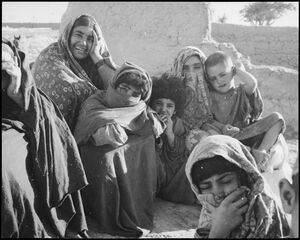
Different regions of Afghanistan have distinctive cultures, partly as a result of geographic obstacles that divide the country.[46] Family is the mainstay of Afghan society and families are often headed by a patriarch.[96] In the southern and eastern region, the people live according to the Pashtun culture by following Pashtunwali (the Pashtun way).[97] Key tenets of Pashtunwali include hospitality, the provision of sanctuary to those seeking refuge, and revenge for the shedding of blood.[98] The Pashtuns are largely connected to the culture of Central Asia and the Iranian Plateau. The remaining Afghans are culturally Persian and Turkic. Some non-Pashtuns who live in proximity with Pashtuns have adopted Pashtunwali in a process called Pashtunization, while some Pashtuns have been Persianized. Those who have lived in Pakistan and Iran over the last 30 years have been further influenced by the cultures of those neighboring nations. The Afghan people are known to be strongly religious.[99]
Afghans, particularly Pashtuns, are noted for their tribal solidarity and high regard for personal honor.[100] One writer considers the tribal system to be the best way of organizing large groups of people in a country that is geographically difficult, and in a society that, from a materialistic point of view, has an uncomplicated lifestyle.[101] There are various Afghan tribes, and an estimated 2–3 million nomads.[102] Afghan culture is deeply Islamic,[100] but pre-Islamic practices persist.[98] One example is bacha bazi, a term for activities involving sexual relations between older men and younger adolescent men, or boys.[103] Child marriage is prevalent in Afghanistan;[104] the legal age for marriage is 16.[105] The most preferred marriage in Afghan society is to one's parallel cousin, and the groom is often expected to pay a bride price.[98]
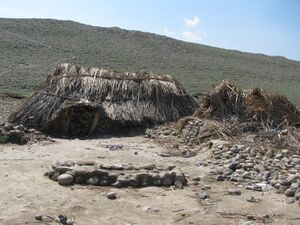
In the villages, families typically occupy mudbrick houses, or compounds with mudbrick or stone walled houses. Villages typically have a headman (malik), a master for water distribution (mirab) and a religious teacher (mullah). Men would typically work on the fields, joined by women during harvest.[96] About 15% of the population are nomadic, locally called kochis.[46] When nomads pass villages they often buy supplies such as tea, wheat and kerosene from the villagers; villagers buy wool and milk from the nomads.[96]
Afghan clothing for both men and women typically consists of various forms of shalwar kameez, especially perahan tunban and khet partug. Women would normally wear a chador for head covering; some women, typically from highly conservative communities, wear the burqa, a full body covering. These were worn by some women of the Pashtun community well before Islam came to the region, but the Taliban enforced this dress on women when they were in power.[106] Another popular dress is the chapan which acts as a coat. The karakul is a hat made from the fur of a specific regional breed of sheep. It was favored by former kings of Afghanistan and became known to much of the world in the 21st century when it was constantly worn by President Hamid Karzai.[107] The pakol is another traditional hat originating from the far east of the country; it was popularly worn by the guerilla leader Ahmad Shah Massoud.[108] The Mazari hat originates from northern Afghanistan.[109]
العمارة
The nation has a complex history that has survived either in its current cultures or in the form of various languages and monuments. Afghanistan contains many remnants from all ages, including Greek and Buddhist stupas, monasteries, monuments, temples and Islamic minarets. Among the most well known are the Great Mosque of Herat, the Blue Mosque, the Minaret of Jam, the Chil Zena, the Qala-i Bost in Lashkargah, the ancient Greek city of Ai-Khanoum.[110] However, many of its historic monuments have been damaged in modern times due to the civil wars.[111] The two famous Buddhas of Bamiyan were destroyed by the Taliban, who regarded them as idolatrous. Despite that, archaeologists are still finding Buddhist relics in different parts of the country, some of them dating back to the 2nd century.[112] As there was no colonialism in the modern era in Afghanistan, European-style architecture is rare; most notably the Victory Arch at Paghman, and the Darul Aman Palace in Kabul, were built in this style in the 1920s by the Afghans themselves.
الفن والخزف
Carpet weaving is an ancient practice in Afghanistan, and many of these are still handmade by tribal and nomadic people today.[113] Carpets have been produced in the region for thousands of years and traditionally done by women.[114] Some crafters express their feelings through the designs of rugs; for example after the outbreak of the Soviet-Afghan War, "war rugs" were created with designs representing pain and misery caused by the conflict.[115] Every province has its own specific characteristics in making rugs.[116] In some of the Turkic-populated areas in the north-west, bride and wedding ceremony prices are driven by the bride's weaving skills.[117]
Pottery has been crafted in Afghanistan for millennia. The village of Istalif, north of Kabul, is in particular a major center, known for its unique turquoise and green pottery,[118] and their methods of crafting have remained the same for centuries.[119][120] Much of lapis lazuli stones were earthed in modern-day Afghanistan which were used in Chinese porcelain as cobalt blue, later used in ancient Mesopotamia and Turkey.[121]
The lands of Afghanistan have a long history of art, with the world's earliest known usage of oil painting found in cave murals in the country.[122][123] A notable art style that developed in Afghanistan and eastern Pakistan is Gandhara Art, produced by a fusion of Greco-Roman art and Buddhist art between the 1st and 7th centuries CE.[124] Later eras saw increased use of the Persian miniature style, with Kamaleddin Behzad of Herat being one of the most notable miniature artists of the Timurid and early Safavid periods. Since the 1900s, the nation began to use Western techniques in art. Abdul Ghafoor Breshna was a prominent Afghan painter and sketch artist from Kabul during the 20th century.
الإعلام والترفيه
Afghanistan has around 350 radio stations and over 200 television stations.[125] Radio Television Afghanistan, originating from 1925, is the state public broadcaster. Television programs began airing in the 1970s and today there are many private television channels such as TOLO and Shamshad TV. The first Afghan newspaper was published in 1873,[98] and there are hundreds of print outlets today.[125] By the 1920s, Radio Kabul was broadcasting local radio services.[126] Voice of America, BBC, and Radio Free Europe/Radio Liberty (RFE/RL) broadcast in both of Afghanistan's official languages on radio.[127] Press restrictions have been gradually relaxed and private media diversified since 2002, after more than two decades of tight controls.
Afghans have long been accustomed to watching Indian Bollywood films and listening to its filmi songs.[128] It has been claimed that Afghanistan is among the biggest markets for the Hindi film industry.[129] The stereotypes of Afghans in India (Kabuliwala or Pathani) has also been represented in some Bollywood films by actors.[130] Many Bollywood film stars have roots in Afghanistan, including Salman Khan, Saif Ali Khan, Shah Rukh Khan, Aamir Khan, Feroz Khan, Kader Khan, Naseeruddin Shah, Zarine Khan, Celina Jaitly, and a number of others. Several Bollywood films have been shot inside Afghanistan, including Dharmatma, Khuda Gawah, Escape from Taliban, and Kabul Express.
الموسيقى
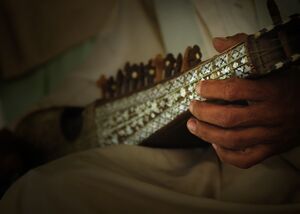
Afghan classical music has close historical links with Indian classical music and use the same Hindustani terminology and theories like raga. Genres of this style of music include ghazal (poetic music) and instruments such as the Indian tabla, sitar and harmonium, and local instruments like zerbaghali, as well as dayereh and tanbur which are also known in Central Asia, the Caucusus and the Middle East. The rubab is the country's national instrument and precurses the Indian sarod instrument. Some of the famous artists of classical music include Ustad Sarahang and Sarban.[131]
Pop music developed in the 1950s through Radio Kabul and was influential in social change. During this time female artists also started appearing, at first Mermon Parwin.[131] Perhaps the most famous artist of this genre was Ahmad Zahir, who synthesized many genres and continues to be renowned for his voice and rich lyrics long after his death in 1979.[132][131] Other notable masters of traditional or popular Afghan music include Nashenas, Ubaidullah Jan, Mahwash, Ahmad Wali, Farhad Darya, and Naghma.[133]
Attan is the national dance of Afghanistan, a group dance popularly performed by Afghans of all backgrounds.[134] The dance is considered part of Afghan identity.[135]
المطبخ
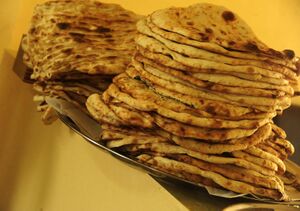
Afghan cuisine is largely based upon the nation's chief crops, such as wheat, maize, barley and rice. Accompanying these staples are native fruits and vegetables as well as dairy products such as milk, yogurt and whey. Kabuli palaw is the national dish of Afghanistan.[136] The nation's culinary specialties reflect its ethnic and geographic diversity.[137] Afghanistan is known for its high quality pomegranates, grapes, and sweet melons.[138] Tea is a favorite drink among Afghans, and a typical diet consists of naan, yoghurts, rice and meat.[96]
الأدب
Classic Persian and Pashto poetry are a cherished part of Afghan culture. Poetry has always been one of the major educational pillars in the region, to the level that it has integrated itself into culture.[139] One of the poetic styles is called landay. A popular theme in Afghan folklore and mythology are Divs, monstrous creatures.[140] Thursdays are traditionally "poetry night" in the city of Herat when men, women and children gather and recite both ancient and modern poems.[141]
The Afghan region has produced countless Persian-speaking poets and writers from the Middle Ages to the present day, among which three mystical authors are considered true national glories (although claimed with equal ardor by Iran), namely: Khwaja Abdullah Ansari of Herat, a great mystic and Sufi saint in the 11th century, Sanai of Ghazni, author of mystical poems in the 12th century, and, finally, Rumi of Balkh, in the 13th century, considered the persophonist throughout the world as the greatest mystical poet of the entire Muslim world. The Afghan Pashto literature, although quantitatively remarkable and in great growth in the last century, has always had an essentially local meaning and importance, feeling the influence of both Persian literature and the contiguous literatures of India. Both main literatures, from the second half of the nineteenth century, have shown themselves to be sensitive to genres (novel, theater), movements and stylistic features imported from Europe.
Khushal Khan Khattak of the 17th century is considered the national poet. Other notable poets include Rabi'a Balkhi, Jami, Rahman Baba, Khalilullah Khalili, and Parween Pazhwak.[142]
العطلات والأعياد
Afghanistan's official New Year starts with Nowruz, an ancient tradition that started as a Zoroastrian celebration in present-day Iran, and with which it shares the annual celebration along with several other countries. It occurs every year at the vernal equinox. In Afghanistan, Nowruz is typically celebrated with music and dance, as well as holding buzkashi tournaments.[143]
Yaldā, another nationally celebrated ancient tradition,[144] commemorates the ancient goddess Mithra and marks the longest night of the year on the eve of the winter solstice (čelle ye zemestān; usually falling on 20 or 21 December),[145][146] during which families gather together to recite poetry and eat fruits—particularly the red fruits watermelon and pomegranate, as well as mixed nuts.[147][148]
Religious festivals are also celebrated; as a predominantly Muslim country, Islamic events and festivals such as Ramadan, Eid al-Fitr and Ashura are widely celebrated annually in Afghanistan. The Sikh festival of Vaisakhi is celebrated by the Sikh community[149] and the Hindu festival Diwali by the Hindu community.[150]
National Independence Day is celebrated on 19 August to mark the Anglo-Afghan Treaty of 1919 under King Amanullah Khan and the country's full independence.[151] Several international celebrations are also officially held in Afghanistan, such as International Workers' Day and International Women's Day. Some regional festivals include the Pamir Festival, which celebrates the culture of the Wakhi and Kyrgyz peoples, the Red Flower Festival (during Nowruz) in Mazar-i-Sharif and the Damboora Festival in Bamyan Province.
الرياضة
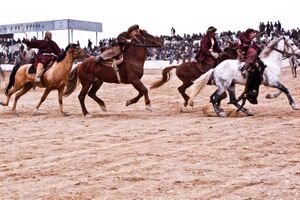
Sport in Afghanistan is managed by the Afghan Sports Federation. Cricket and association football are the two most popular sports in the country.[152][153] The Afghan Sports Federation promotes cricket, association football, basketball, volleyball, golf, handball, boxing, taekwondo, weightlifting, bodybuilding, track and field, skating, bowling, snooker, chess, and other sports.
Afghanistan's sports teams are increasingly celebrating titles at international events. Its basketball team won the first team sports title at the 2010 South Asian Games.[154] Later that year, the country's cricket team followed as it won the 2009–10 ICC Intercontinental Cup.[155] In 2012, the country's 3x3 basketball team won the gold medal at the 2012 Asian Beach Games. In 2013, Afghanistan's football team followed as it won the SAFF Championship.[156]
The Afghan national cricket team, which was formed in 2001, participated in the 2009 ICC World Cup Qualifier, 2010 ICC World Cricket League Division One and the 2010 ICC World Twenty20. It won the ACC Twenty20 Cup in 2007, 2009, 2011 and 2013. The team eventually made it and played in the 2015 Cricket World Cup.[157] The Afghanistan Cricket Board (ACB) is the official governing body of the sport and is headquartered in Kabul. The Alokozay Kabul International Cricket Ground serves as the nation's main cricket stadium. There are several other stadiums throughout the country, including the Ghazi Amanullah Khan International Cricket Stadium near Jalalabad. Domestically, cricket is played between teams from different provinces.
The Afghanistan national football team has been competing in international football since 1941.[158] The national team plays its home games at the Ghazi Stadium in Kabul, while football in Afghanistan is governed by the Afghanistan Football Federation. The national team has never competed or qualified for the FIFA World Cup but has recently won an international football trophy in 2013.[156] The country also has a national team in the sport of futsal, a 5-a-side variation of football.
The traditional and the national sport of Afghanistan is buzkashi, mainly popular in the north, but also having a following in other parts of the country.[159] It is similar to polo, played by horsemen in two teams, each trying to grab and hold a goat carcass.[160] The Afghan Hound (a type of running dog) originated in Afghanistan and was formerly used in wolf hunting. In 2002, traveler Rory Stewart reported that dogs were still used for wolf hunting in remote areas.[161]
مرئيات
| طالبان تبدأ حملة لقطع رؤوس المانيكانات النسائية |
انظر أيضاً
ملاحظات
الهامش
- ^ [[[:قالب:Geonameslink]] Islamic Republic of Afghanistan] in [[[:قالب:Geonamesabout]] Geonames.org (cc-by)]
- ^ خطأ استشهاد: وسم
<ref>غير صحيح؛ لا نص تم توفيره للمراجع المسماةLoC-pdf - ^ Dictionary.com. The American Heritage Dictionary of the English Language, Fourth Edition. Houghton Mifflin Company, 2004. Reference.com (Retrieved 13 November 2007).
- ^ Dictionary.com. WordNet 3.0. Princeton University. Reference.com (Retrieved 13 November 2007). Archived 28 مارس 2014 at the Wayback Machine
- ^ "Constitution of Afghanistan". 2004. Archived from the original on 20 September 2016. Retrieved 16 February 2013.
- ^ Afghan | meaning in the Cambridge English Dictionary. the Cambridge English Dictionary. ISBN 9781107660151.
- ^ Central Statistics Office Afghanistan
- ^ Central Statistics Office Afghanistan, 2020.
- ^ أ ب ت ث "Afghanistan". International Monetary Fund. Retrieved 14 November 2018.
- ^ "Gini Index". World Bank. Archived from the original on 11 May 2014. Retrieved 2 March 2011.
- ^ Human Development Report 2020 The Next Frontier: Human Development and the Anthropocene (PDF). United Nations Development Programme. 15 December 2020. pp. 343–346. ISBN 978-92-1-126442-5. Retrieved 16 December 2020.
- ^ Afghanistan: An Introduction
- ^ Library of Congress Country Studies on Afghanistan, Chapter 1. Historical Setting, by Craig Baxter (1997).
- ^ Kingdoms of South Asia - Afghanistan in Far East Kingdoms: Persia and the East
- ^ عصام عبدالرؤوف ، بلاد الهند في العصر الاسلامي ـ ص 34
- ^ محمود اسماعيل ، سوسولوجيا الفكر الاسلامي ، طور الانهيار ،ص 102
- ^ حسان حلاق ، تاريخ الشعوب الاسلامية ، مادة الافغان
- ^ عصام عبدالرؤوف ، بلاد الهند في العصر الاسلامي ـ ص 133
- ^ ابن بطوطة ، الرحلة ، ص 377
- ^ Last Afghan Empire, Afghanpedia.
- ^ قالب:يستشهد موسوعة
- ^ قالب:يستشهد موسوعة
- ^ Ahmad Shah Durrani, Britannica Concise.
- ^ The Decline of the Pashtuns in Afghanistan, Anwar-ul-Haq Ahady, Asian Survey, Vol. 35, No. 7. (Jul., 1995), pp. 621–634.
- ^ ^ « جمال الدين الافغاني ر إسلامي علوم كي تحقيق (جمال الافغاني وخدماته في البحوث العلمية الإسلامية)» د.محمود هاشم قاسمي ، مجلة تحقيقات إسلامي، علي جراه، الهند، يناير-مارس 2014 م، ص. 21.
- ^ "NATO to Cut Forces in Afghanistan, Match US Withdrawal". VOA News. 14 April 2021.
- ^ Robertson, Nic (24 June 2021). "Afghanistan is disintegrating fast as Biden's troop withdrawal continues". CNN.
- ^ "Afghanistan stunned by scale and speed of security forces' collapse". The Guardian. 13 July 2021.
- ^ "Afghan government could fall within six months of U.S. military withdrawal, new intelligence assessment says". The Washington Post (in الإنجليزية الأمريكية). 24 June 2021. ISSN 0190-8286.
- ^ "The Afghan government's collapse is a humiliation for the US and Joe Biden". New Statesman. August 15, 2021. Retrieved August 15, 2021.
- ^ "President Ashraf Ghani Flees Afghanistan, Taliban Take Over Kabul: Report". NDTV.com. Archived from the original on 15 August 2021. Retrieved 15 August 2021.
- ^ "'Coordination council' to oversee peaceful transfer of power in Afghanistan: Karzai". The Express Tribune. August 15, 2021. Retrieved August 16, 2021.
- ^ "An anti-Taliban front forming in Panjshir? Ex top spy Saleh, son of 'Lion of Panjshir' meet at citadel". The Week (in الإنجليزية). Retrieved 2021-08-17.
- ^ "Afghan Vice President Saleh Declares Himself Caretaker President; Reaches Out To Leaders for Support". News18 (in الإنجليزية). 2021-08-17. Retrieved 2021-08-17.
- ^ * "U.S. maps". Pubs.usgs.gov. Archived from the original on 25 December 2013. Retrieved 19 May 2012.
- "South Asia: Data, Projects, and Research". Archived from the original on 1 March 2015. Retrieved 2 March 2015.
- "MAPS SHOWING GEOLOGY, OIL AND GAS FIELDS AND GEOLOGICAL PROVINCES OF SOUTH ASIA (Includes Afghanistan)". Archived from the original on 25 December 2013. Retrieved 2 March 2015.
- "University of Washington Jackson School of International Studies: The South Asia Center". Archived from the original on 2 April 2015. Retrieved 2 March 2015.
- "Syracruse University: The South Asia Center". 26 March 2013. Archived from the original on 26 March 2015. Retrieved 2 March 2015.
- "Center for South Asian studies". Archived from the original on 11 December 2007. Retrieved 2 March 2015.
- ^ "Composition of macro geographical (continental) regions, geographical sub-regions, and selected economic and other groupings". UNdata. 26 April 2011. Archived from the original on 13 July 2011. Retrieved 13 July 2011.
- ^ "Afghanistan". Encyclopædia Britannica. Archived from the original on 25 February 2010. Retrieved 17 March 2010.
- ^ Tan, Anjelica (18 February 2020). "A new strategy for Central Asia". TheHill.
, as Afghan President Ashraf Ghani has noted, Afghanistan is itself a Central Asian country.
- ^ Afghanistan | meaning in the Cambridge English Dictionary. Cambridge University. ISBN 9781107619500.
- ^ Neelis, Jason (19 November 2010). Early Buddhist Transmission and Trade Networks: Mobility and Exchange Within and Beyond the Northwestern Borderlands of South Asia. BRILL. ISBN 978-9004181595.
- ^ "Archived copy". Archived from the original on 30 August 2020. Retrieved 17 June 2020.
{{cite web}}: CS1 maint: archived copy as title (link) - ^ "Land area (sq. km)". World Development Indicators. World Bank. 2011. Archived from the original on 29 October 2013. Retrieved 13 October 2011.
- ^ "CIA Factbook – Area: 41". CIA. 26 November 1991. Archived from the original on 31 January 2014. Retrieved 4 February 2012.
- ^ https://www.mha.gov.in/sites/default/files/BMIntro-1011.pdf
- ^ Cary Gladstone (2001). Afghanistan Revisited. Nova Publishers. p. 121. ISBN 978-1-59033-421-8.
- ^ أ ب ت ث Fisher, W. B. (2002). "Afghanistan: Physical and Social Geography". The Far East and Australasia 2003. Psychology Press. pp. 59–60. ISBN 9781857431339.
- ^ Whitehead, Kim (21 October 2014). Afghanistan. Simon and Schuster. ISBN 9781633559899.
- ^ "Forests of Afghanistan" (PDF). cropwatch.unl.edu. Retrieved 28 June 2021.
- ^ خطأ استشهاد: وسم
<ref>غير صحيح؛ لا نص تم توفيره للمراجع المسماةFactbook - ^ "History of Environmental Change in the Sistan Basin 1976–2005" (PDF). Archived (PDF) from the original on 7 August 2007. Retrieved 20 July 2007.
- ^ "Afghanistan Rivers Lakes – Afghanistan's Web Site". www.afghanistans.com.
- ^ "Snow in Afghanistan: Natural Hazards". NASA. 3 February 2006. Archived from the original on 30 December 2013. Retrieved 6 May 2012.
- ^ "Snow may end Afghan drought, but bitter winter looms". Reuters. 18 January 2012. Archived from the original on 30 December 2013.
- ^ "Afghanistan's woeful water management delights neighbors". The Christian Science Monitor. 15 June 2010. Archived from the original on 14 November 2010. Retrieved 14 November 2010.
- ^ قالب:Cite techreport
- ^ "Earthquake Hazards". USGS Projects in Afghanistan. US Geological Survey. 1 August 2011. Archived from the original on 4 October 2011. Retrieved 13 October 2011.
- ^ "'Seven dead' as earthquake rocks Afghanistan". BBC News. 19 April 2010. Archived from the original on 31 December 2013. Retrieved 13 October 2011.
- ^ Explaining Elections, Independent Election Commission of Afghanistan
- ^ „A survey of the Afghan people – Afghanistan in 2006“, The Asia Foundation, unterstützt durch U.S. Agency for International Development, Befragungen durchgeführt von Afghan Center for Socio-economic and Opinion Research (ACSOR), Kabul, 2006, PDF, basierend auf 6226 Interviews, alle Provinzen außer Uruzgan und Zabul (S.85), Werte auf S. 84, abgerufen am 17. März 2009
- ^ „A survey of the Afghan people – Afghanistan in 2007“, The Asia Foundation, unterstützt durch U.S. Agency for International Development, Befragungen durchgeführt von Afghan Center for Socio-economic and Opinion Research (ACSOR), Kabul, 2007, PDF, basierend auf 6263 Interviews, alle Provinzen (S.115), Werte auf S. 114, abgerufen am 17. März 2009
- ^ ABC News, BBC und أيه أر دي: Afghanistan – Where things stand, 9. Februar 2009, PDF, Befragung von 1534 Personen (2009), alle Provinzen berücksichtigt (S. 14), Werte für 2009 und 2007: Pashtun 40 % 38 %, Tajik 37 % 38 %, Hazara 11 % 6 %, Usbek 7 % 6 %, Aimak 0 % 0 %, Turkmen 2 % 2 %, Baloch 1 % 3 %, Nuristani 1 % 4 %, Arab 2 % 0 % (S. 38), abgerufen am 17. März 2009
- ^ تاريخ الأفغان ، جمال الدين الأفغاني ، طبعة مؤسسة هنداوي ، القاهرة ، 2009 ، ص 22.
- ^ مير غلام محمد غبار. افغانستان د تاريخ په پېر کې، چاپکال، ۱۹۹۹.
- ^ أفغانستان في التاريخ ، محمد فهيم ، كراجي ، باكستان ، 2013 ، ص32 .
- ^ مير غلام محمد غبار. افغانستان د تاريخ په پېر کې، چاپکال، ۱۹۹۹، ص231.
- ^ مير غلام محمد غبار. افغانستان د تاريخ په پېر کې، چاپکال، ۱۹۹۹، ص541.
- ^ مير غلام محمد غبار. افغانستان د تاريخ په پېر کې، چاپکال، ۱۹۹۹ ، ص871.
- ^ أ ب عصام عبدالرؤوف ، بلاد الهند في العصر الاسلامي ـ ص 124
- ^ مير غلام محمد غبار. افغانستان د تاريخ په پېر کې، چاپکال، ۱۹۹۹، ص 231.
- ^ جورنج.آر. (تعليم)"قاموس لاروس للمعتقدات والأديان" (لاروس- 1994) ص. 585-58
- ^ أ ب خطأ استشهاد: وسم
<ref>غير صحيح؛ لا نص تم توفيره للمراجع المسماةCIA - ^ [144] ^ دائرة المعارف البريطانية - أفغانستان... وصلة (PDF)
- ^ [145] ^ جورنج.آر. (تعليم)"قاموس لاروس للمعتقدات والأديان" (لاروس- 1994) ص. 581-58، والجدول : "التوزيع السكاني حسب المعتقدات الرئيسية"، الرقم الدولي المعياري للكتاب 0-7523-0000-8، ملاحظة ما يلي : "... الأرقام التي تم جمعها من أدق المعلومات المتاحة حاليا، وهي صحيحة في معظم الأحيان لأقرب 1%...."
- ^ الهندوسية اليوم : الهندوس تخلوا عن أفغانستان.
- ^ بي بي سي في جنوب آسيا : نضال السيخ في أفغانستان.
- ^ [148] ^ [1] Washingtonpost.com - البلد الأفغاني اليهودي الوحيد والأوحد - أن.سي. ايزنمان.
- ^ Morales, Victor (2005-03-28). "Poor Afghanistan". Voice of America. Archived from the original on 2006-08-27. Retrieved 2006-09-10.
- ^ North, Andrew (2004-03-30). "Why Afghanistan wants $27.6bn". BBC News. Retrieved 2006-09-10.
- ^ CIA - The World Factbook - Afghanistan
- ^ أ ب ت فوجيمورا، مانابو "الاقتصاد الأفغاني بعد الانتخابات"، مؤسسة بنك التنمية الآسيوي .
- ^ [156] ^ شبكة باجهوك الإخبارية الأفغانية، أفغانستان تتلقى تحويلات مالية تقدر بـ 3,3 مليار دولار من المغتربين، 19 أكتوبر 2007
- ^ U.S. Embassy, Kabul, Third Afghanistan Marble Conference, May 25, 2011.
- ^ & الاقتصاد الكلي والنمو الاقتصادي في جنوب آسيا، والبنك الدولي.
- ^ [159] ^ إنتاج الافيون الأفغاني يسجل رقمًا مرتفعًا.
- ^ [160] ^ الرعب يسود الامم المتحدة من زيادة تجارة الافيون في اقليم هلمند.
- ^ الخشخاش للسلام : إصلاح صناعة الافيون في أفغانستان.
- ^ " تقرير جريدة ميدياي للأعمال: وحدة شركة بلاك & فيتش تحصد عقد أفغاني"، جريدة كينساس سيتي ستار.
- ^ " افتتاح مصنع تعبئة كوكا كولا في أفغانستان"، كونترا كوستا تايمز.
- ^ كابول -- مشروع مدينة النور.
- ^ خطأ استشهاد: وسم
<ref>غير صحيح؛ لا نص تم توفيره للمراجع المسماةAfghanMinerals - ^ خطأ استشهاد: وسم
<ref>غير صحيح؛ لا نص تم توفيره للمراجع المسماةPajhwok - ^ [173] ^ شبكة باجهوك الإخبارية الأفغانية، الموارد المعدنية الضخمة لدى أفغانستان: استقصاء، 14 نوفمبر 2007.
- ^ خطأ استشهاد: وسم
<ref>غير صحيح؛ لا نص تم توفيره للمراجع المسماةEurasianet - ^ باجوك الأفغانية نيوز، شركة صينية تفوز مناقصة إيناك لاستخراج النحاس، 20 نوفمبر 2007.
- ^ "تعداد أفغانستان المتوقع 2012-13". Central Statistics Office. Retrieved September 30, 2015.
- ^ أ ب ت ث "Afghanistan Way of Life | Afghanistan's Web Site". www.afghanistans.com.
- ^ Blood, Peter R., ed. (1998). "Pashtun". Afghanistan: a country study. Washington, D.C.: Library of Congress, Federal Research Division. OCLC 904447770. Archived from the original on 17 October 2004. Retrieved 23 January 2021.
 هذا المقال يضم نصاً من هذا المصدر، الذي هو مشاع.
هذا المقال يضم نصاً من هذا المصدر، الذي هو مشاع.{{cite encyclopedia}}: CS1 maint: postscript (link) - ^ أ ب ت ث Dupree 1997.
- ^ خطأ استشهاد: وسم
<ref>غير صحيح؛ لا نص تم توفيره للمراجع المسماةauto6 - ^ أ ب Barfield 2012.
- ^ Heathcote, Tony (1980, 2003) "The Afghan Wars 1839–1919", Sellmount Staplehurst.
- ^ "Afghanistan: Kuchi nomads seek a better deal". IRIN Asia. 18 February 2008. Archived 10 سبتمبر 2011 at the Wayback Machine
- ^ Qobil, Rustam (7 September 2010). "The sexually abused dancing boys of Afghanistan". BBC News. Archived from the original on 18 August 2019. Retrieved 20 September 2019.
- ^ Bahgam, S; Mukhatari (2004). "Study on Child Marriage in Afghanistan" (PDF). Medica Mondiale: 1–20. Archived from the original (PDF) on 6 May 2012. Retrieved 15 March 2014.
- ^ "Afghanistan Has a Tougher Law on Child Marriage than Florida". Human Rights Watch. 20 October 2017. Archived from the original on 25 July 2019. Retrieved 15 September 2019.
In Afghanistan girls can marry at 16, or at 15 with permission from their father or a judge.
- ^ Amer, Sahar (2 September 2014). What Is Veiling?. UNC Press Books. ISBN 9781469617763.
- ^ "Karzai heads for hat trouble". 28 April 2002 – via news.bbc.co.uk.
- ^ "Traditional Afghan Clothes". 12 March 2018.
- ^ "Hats Proliferate as Symbol of Pashtun Protest Movement | Voice of America – English". www.voanews.com.
- ^ "Afghanistan Art and Architecture | Afghanistan's Web Site". www.afghanistans.com.
- ^ G.V. Brandolini. Afghanistan cultural heritage. Orizzonte terra, Bergamo. 2007. p. 64.
- ^ "Afghan archaeologists find Buddhist site as war rages". Sayed Salahuddin. 17 August 2010. Archived from the original on 18 August 2010. Retrieved 16 August 2010.
- ^ خطأ استشهاد: وسم
<ref>غير صحيح؛ لا نص تم توفيره للمراجع المسماةauto5 - ^ "In Afghanistan, weaving ancient industry back into global market". The Christian Science Monitor. 21 August 2019.
- ^ "Selling war: commodifying the (in)security of Afghan women". SPERI. 15 January 2020.
- ^ "Weaving Culture through the Afghan rug". 7 December 2017.
- ^ "Rug Weavers and Bride Prices in the Northwest: Still expensive in spite of government and Taleban rules". Afghanistan Analysts Network – English. 12 May 2019.
- ^ "Giving Back – Seret and Sons".
- ^ "The Potter: Crafting Afghanistan's future". The Khaama Press News Agency. 27 January 2015.
- ^ Fahim, Kareem (18 August 2016). "War and Pillaging Couldn't Break an Afghan Village, but a Tumbling Economy May". The New York Times.
- ^ Wilkinson, Isambard. "How the quest for the 'perfect blue' changed art forever". CNN.
- ^ "First-ever oil paintings found in Afghanistan". CNN. 24 April 2008. Retrieved 3 December 2012.
- ^ "World's Oldest Oil Paintings Found in Afghanistan". Fox News. 24 April 2008. Retrieved 3 December 2012.
- ^ "Gandhara art". Britannica. Retrieved 22 August 2018.
- ^ أ ب "Suspects Sentenced To Death For Killing Journalist in Kandahar". TOLOnews. 16 April 2019. Archived from the original on 17 April 2019. Retrieved 28 July 2019.
- ^ Monica Whitlock (24 October 2003). Land Beyond the River: The Untold Story of Central Asia. St. Martin's Press. p. 127. ISBN 978-0-312-27727-7.
- ^ "Freedom of the Press 2016: Afghanistan". Freedom House. 2016. Archived from the original on 5 February 2017. Retrieved 28 July 2016.
- ^ "Encounters with Bollywood in Kabul". Himal Southasian. 14 September 2013.
- ^ "Bollywood's Panipat irks Afghans over founding father's portrayal". www.aljazeera.com.
- ^ "Vilifying Afghans in Bollywood". www.telegraphindia.com.
- ^ أ ب ت "Afghanistan – The Rough Guide to World Music". Songlines.
- ^ "Ahmad Zahir: The Voice of Afghanistan". daily.redbullmusicacademy.com.
- ^ "Artist Biographies". Afghanland.com. Archived from the original on 9 August 2013. Retrieved 17 October 2011.
- ^ "Afghanistan's Traditional Dance-Attan". 7 July 2012.
- ^ "Attan – the fascinating national dance of Afghanistan". Afghan Zariza.
- ^ Ali, Tanveer (31 July 2012). "Everything You Need To Know About Afghan Food". foodrepublic. Archived from the original on 13 February 2013.
- ^ Brittin, Helen (2011). The Food and Culture Around the World Handbook. Boston: Prentice Hall. pp. 20–21.
- ^ "Rare Heirloom Seeds – Baker Creek Heirloom Seeds". Baker Creek Heirloom Seeds. Archived from the original on 4 March 2016. Retrieved 28 October 2013.
- ^ "FEATURE: In Western Afghanistan, an ancient love of poetry thrives again". UN News. 5 October 2017.
- ^ Fee, Christopher R.; Webb, Jeffrey B. (29 August 2016). American Myths, Legends, and Tall Tales: An Encyclopedia of American Folklore [3 volumes]: An Encyclopedia of American Folklore (3 Volumes). ABC-CLIO. ISBN 9781610695688.
- ^ "Afghanistan: 10 facts you may not know". BBC News. 6 July 2011. Archived from the original on 4 March 2018. Retrieved 21 June 2018 – via BBC.
- ^ "Classical Dari and Pashto Poets". Afghan-web.com. Archived from the original on 12 April 2014. Retrieved 4 February 2012.
- ^ "Afghanistan Holidays and Festivals". www.iexplore.com.
- ^ Rezaian, Lachin (20 December 2015). "Yalda: Iranian celebration of winter solstice". Mehr News Agency.
- ^ Roessing, Lesley (2012). No More "us" and "them": Classroom Lessons and Activities to Promote Peer Respect. p. 89. ISBN 978-1-61048-812-9.
- ^ Hamedy, Saba (20 December 2013). "In ancient tradition, Iranians celebrate winter solstice". Los Angeles Times.
- ^ Foltz, Richard (2013). Religions of Iran: From Prehistory to the Present. Oneworld Publications. p. 29. ISBN 978-1-78074-307-3.
- ^ Alavi, Nasrin (8 November 2015). We Are Iran: The Persian Blogs. Soft Skull Press. p. 135.
- ^ "Sikhs throng temples to celebrate Vaisakhi". www.pajhwok.com.
- ^ "Afghan Hindus and Sikhs celebrate Diwali without 'pomp and splendour' amid fear". The National. 19 October 2017.
- ^ "The World Factbook: Afghanistan". Central Intelligence Agency. 7 September 2009. Retrieved 18 August 2009.
- ^ Uthra Ganesan (11 January 2016). "Cricket is now the biggest sport in Afghanistan". The Hindu. Retrieved 4 July 2019.
- ^ "Sport in Afghanistan". Top End Sports. Archived from the original on 11 July 2018. Retrieved 4 July 2019.
- ^ "South Asian Games: Shooters, swimmers shine as India consolidate dominance". The Times of India. 5 February 2010. Archived from the original on 13 June 2019. Retrieved 28 May 2019.
- ^ "2009–10 Intercontinental Cup". CricketEurope. Archived from the original on 24 February 2013. Retrieved 28 May 2019.
- ^ أ ب Lyse, Doucet (12 September 2013). "Precious moments of unity touch Afghans after football triumph". BBC News. Archived from the original on 25 September 2013. Retrieved 28 May 2019.
- ^ "Afghanistan Makes History in Cricket World Cup, Despite Debut Loss to Bangladesh". 20 February 2015. Archived from the original on 28 May 2019. Retrieved 28 May 2019.
- ^ "Statistics: Iran". Team Melli. Archived from the original on 3 November 2019. Retrieved 28 May 2019.
- ^ "Afghanistan's buzkashi horses prepare for the game of courage". The Hindu. 17 January 2018 – via www.thehindu.com.
- ^ Abi-Habib, Maria; Fazly, Walid (13 April 2011). "In Afghanistan's National Pastime, It's Better to Be a Hero Than a Goat". The Wall Street Journal. Archived from the original on 26 May 2015. Retrieved 13 April 2011.
- ^ Stewart, Rory (2007). The Places in Between. HMH Books. p. 100. ISBN 978-0-15-603593-4.
وصلات خارجية
- Office of the President
- Afghanistan. The World Factbook. Central Intelligence Agency.
- أفغانستان web resources provided by GovPubs at the University of Colorado Boulder Libraries
- أفغانستان at Curlie
 Wikimedia Atlas of Afghanistan
Wikimedia Atlas of Afghanistan- Research Guide to Afghanistan
- Pages using gadget WikiMiniAtlas
- CS1 الإنجليزية الأمريكية-language sources (en-us)
- CS1 maint: postscript
- Short description with empty Wikidata description
- Coordinates not on Wikidata
- صفحات بها وصلات إنترويكي للإزالة
- Articles with hatnote templates targeting a nonexistent page
- Articles with Curlie links
- أفغانستان
- تأسيسات 1709 في آسيا
- أعضاء منظمة التعاون الإسلامي
- البلدان الأقل نماء
- الهضبة الإيرانية
- بلدان حبيسة
- بلدان ومقاطعات ناطقة بالفارسية
- جمهوريات
- جمهوريات إسلامية
- الدول الأعضاء في الأمم المتحدة
- دول إسلامية
- دول الشرق الأوسط
- دول جنوب آسيا
- دول وسط آسيا
- مناطق تحت الإحتلال العسكري
